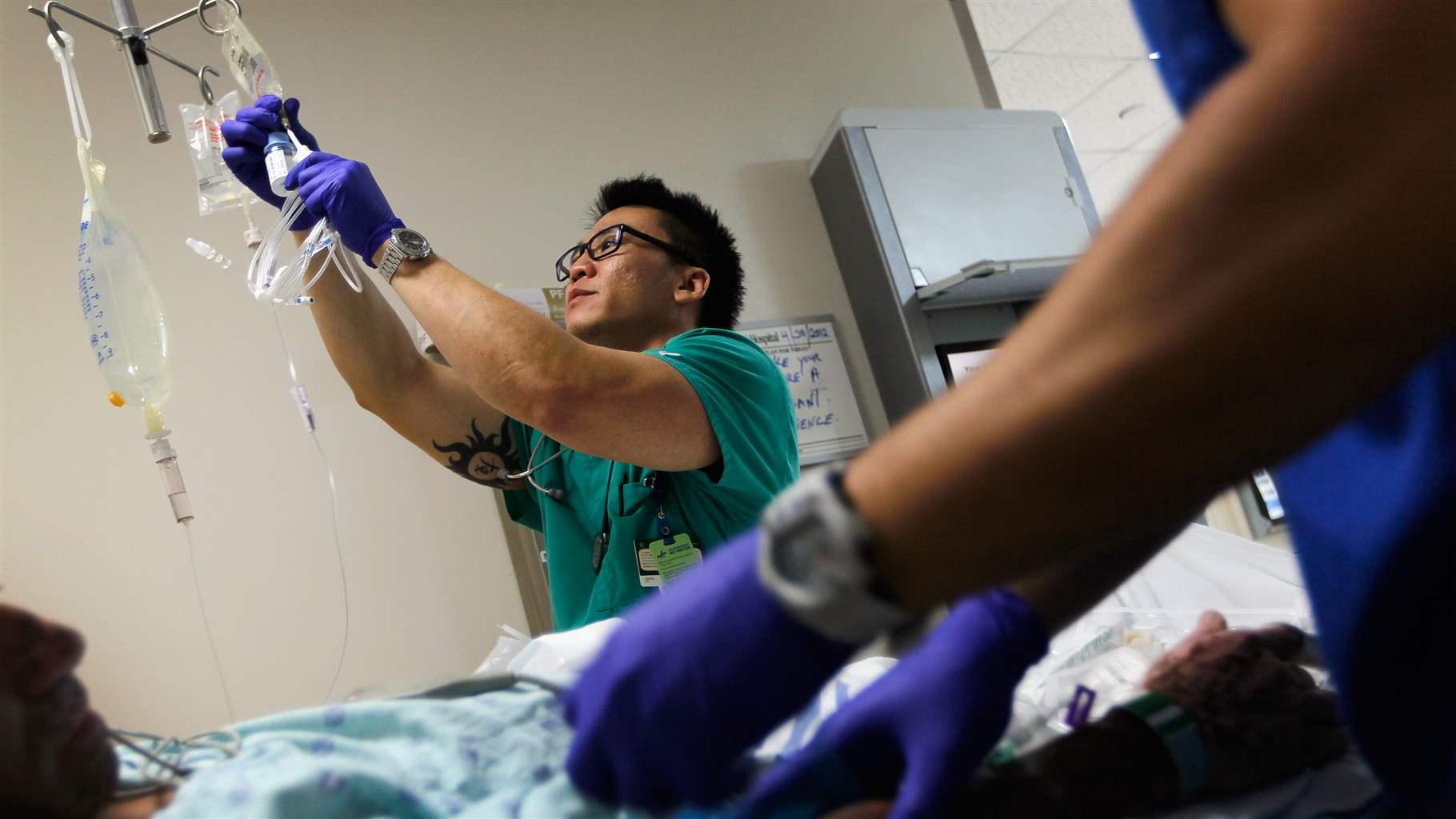Emergency Departments Can Help People with Opioid Use Disorder Start Treatment
State and local approaches show that medication initiation and provider coordination improve patient outcomes

Hospital emergency departments (EDs) are a critical access point to the health care system, and effective ED programs can help improve health outcomes for individuals with opioid use disorder (OUD), a chronic disease experienced by more than 1.6 million Americans. Emergency rooms today are handling a growing caseload of overdose survivors.
According to the latest available federal numbers, opioid-related ED visits increased by 112% between 2010 and 2017. And research shows that those who have experienced a nonfatal drug overdose are at increased risk for a fatal opioid overdose.
To support emergency departments as they care for and engage patients following opioid overdoses, state health care decision-makers should adopt—and Medicaid agencies should fund—a range of care coordination strategies based on successful approaches around the country. Coordination of the different components helps ensure that all key providers have the information needed to deliver safe and effective care for each patient.
Initiate treatment with OUD medications
Federal regulations allow the administration of buprenorphine and methadone, both Food and Drug Administration-approved medications for OUD, in emergency situations—such as when a person is brought to the ED following an opioid overdose—for up to three days to relieve withdrawal symptoms and provide care until the patient is connected to ongoing treatment.
A randomized controlled trial involving 329 patients at a large teaching hospital in Rhode Island demonstrated that patients who received buprenorphine while in emergency department care had higher rates of treatment engagement at 30- and 60-day follow-up points. In that 2015 study, those same individuals reported less illicit opioid use and less use of inpatient addiction treatment services compared with people who received only a brief intervention or referral to care.
In San Francisco, a retrospective study published in 2020 of 77 patients who received buprenorphine at a large public hospital following opioid withdrawal showed that treatment initiation protocols can begin even with limited staffing: A team of one emergency physician and one pharmacist developed this hospital’s program. About one-third of patients known to the researchers had followed up with the designated outpatient treatment provider within one week of ED discharge, though more may have received ongoing care from other providers. The hospital achieved this follow-up rate despite referring all patients to an outpatient clinic, including those who may have been less ready to engage in continued treatment.
Facilitate transitions to community-based care
Research makes clear that care coordination models, which organize patient care activities and share information among all participants concerned with an individual’s treatment plan, improve health outcomes; the data shows that patients whose care is coordinated have reduced 30-day readmission rates, hospitalizations, and emergency department visits. Many exemplary care coordination programs based in emergency departments use peer recovery coaches—individuals who are in recovery themselves—to ensure that people with OUD receive continued treatment after emergency care. Peers can assist patients by sharing their own experiences, educating about overdose prevention and how to use naloxone, and providing referrals to community-based care and social services.
One buprenorphine initiation pilot program based in the emergency departments at three hospitals in South Carolina utilized specially trained peers who worked with clinical staff to identify and provide care for patients with OUD. They used a screening, brief intervention, and referral to treatment (SBIRT) model, an approach to detecting substance misuse by universally screening patients. The peers assessed patients’ readiness for change and motivation for treatment. They also helped those who recently started treatment make follow-up appointments with “fast track” providers at outpatient referral clinics able to see them the next day and continue care without delay.
In this state-funded model, a local public drug and alcohol treatment program hired and supervised the peers, who received 40 hours of in-person training with a component about medications to treat OUD. An evaluation of 241 patients who received ED-initiated buprenorphine at the South Carolina hospitals found that 78% attended their next-day follow-up appointment, and 59% of that group remained in treatment after 30 days.
Leverage state and federal funding for care coordination
With support from state and federal funding sources, such as State Targeted Response to the Opioid Crisis (STR) and State Opioid Response (SOR) grants, states are funding care coordination models that serve emergency department patients with OUD.
In Washington state, 7 Opioid Treatment Networks (OTNs) based in emergency departments are using SOR grant funding to initiate medications for OUD and provide connections to community-based care for people with OUD. Staffed by a buprenorphine-licensed provider, a nurse care manager, a care navigator, and a data collector, each OTN uses the funding for infrastructure, staff, medications, and services for individuals transitioning to community-based care. In addition to emergency departments, the state’s 15 OTNs are also located in jails, a syringe exchange, a shelter, and a fire department. They served more than 7,500 individuals in the first two years of program implementation.
By funding and implementing programs that expand access to medications for OUD and help patients transition to community care, state health care decision-makers are improving outcomes for people with OUD. States have several promising models to choose from in designing programs tailored to their needs, including innovative care coordination approaches based in emergency departments that have been implemented in Colorado, Kentucky, New Jersey, Ohio, Rhode Island, and elsewhere.
The U.S. Substance Abuse and Mental Health Services Administration also recently published a report for health care providers and administrators that details use of and evidence for emergency department-initiated strategies that incorporate OUD medications. Between established success stories and federal guidance backed by data, policymakers should consider how to best use community emergency departments to help manage this ongoing crisis.
Ian Reynolds is a senior manager and Victoria Yastishock is an associate with The Pew Charitable Trusts’ substance use prevention and treatment initiative.








